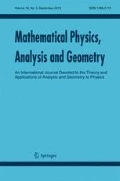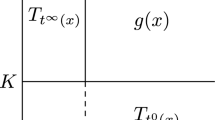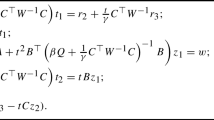Abstract
The two-matrix model can be solved by introducing biorthogonal polynomials. In the case the potentials in the measure are polynomials, finite sequences of biorthogonal polynomials (called windows) satisfy polynomial ODEs as well as deformation equations (PDEs) and finite difference equations (ΔE) which are all Frobenius compatible and define discrete and continuous isomonodromic deformations for the irregular ODE, as shown in previous works of ours. In the one matrix model an explicit and concise expression for the coefficients of these systems is known and it allows to relate the partition function with the isomonodromic tau-function of the overdetermined system. Here, we provide the generalization of those expressions to the case of biorthogonal polynomials, which enables us to compute the determinant of the fundamental solution of the overdetermined system of ODE + PDEs + ΔE.
Similar content being viewed by others
References
Adler M. and Van Moerbeke, P.: String-orthogonal polynomials, string equations and 2-Toda symmetries, Commun. Pure Appl. Math. J. 50 (1997), 241–290.
Adler, M. and Van Moerbeke, P.: The spectrum of coupled random matrices, Ann. of Math. (2) 149 (1999), 921–976.
Bleher, P. and Its, A.: Semiclassical asymptotics of orthogonal polynomials, Riemann–Hilbert problem, and universality in the matrix model, Ann. of Math. (2) 150(1) (1999), 185–266.
Deift, P., Kriecherbauer, T., McLaughlin, K. T. R., Venakides, S. and Zhou, Z.: Uniform asymptotics for polynomials orthogonal with respect to varying exponential weights and applications to universality questions in random matrix theory, Commun. Pure Appl. Math. 52 (1999), 1335–1425.
Deift, P., Kriecherbauer, T., McLaughlin, K. T. R., Venakides, S. and Zhou, Z.: Strong asymptotics of orthogonal polynomials with respect to exponential weights, Commun. Pure Appl. Math. 52 (1999), 1491–1552.
Fokas, A., Its, A. and Kitaev, A.: The isomonodromy approach to matrix models in 2D quantum gravity, Commun. Math. Phys. 147 (1992), 395–430.
Bertola, M., Eynard, B. and Harnad, J.: Partition functions for matrix models and isomonodromic tau functions, J. Phys. A 36 (2003), 3067–3083.
Bertola, M., Eynard, B. and Harnad, J.: Differential systems for bi-orthogonal polynomials appearing in two-matrix models and the associated Riemann–Hilbert problem, Commun. Math. Phys. 243 (2003), 193–240.
Kapaev, A. A.: The Riemann–Hilbert problem for the bi-orthogonal polynomials, J. Phys. A 36 (2003), 4629–4640.
Bertola, M., Eynard, B. and Harnad, J.: Duality, biorthogonal polynomials and multi-matrix models, Comm. Math. Phys. 229 (2002), 73–120.
Bertola, M., Eynard, B. and Harnad, J.: Duality of spectral curves arising in two-matrix models, Theor. Math. Phys. 134(1) (2003), 27–32.
Kazakov, V. A.: Ising model on a dynamical planar random lattice: exact solution, Phys. Lett. A 119 (1986), 140–144.
Daul, J. M., Kazakov, V. and Kostov, I. K.: Rational theories of 2D gravity from the two-matrix model, Nucl. Phys. B 409 (1993), 311–338, hepth/9303093.
Di Francesco, P., Ginsparg, P. and Zinn-Justin, J.: 2D gravity and random matrices, Phys. Rep. 254 (1995), 1.
Bauldry, W.: Estimates of asymmetric Freud polynomials on the real line, J. Approx. Theory 63 (1990), 225–237.
Bonan, S. S. and Clark, D. S.: Estimates of the Hermite and the Freud polynomials, J. Approx. Theory 63 (1990), 210–224.
Jimbo, M., Miwa, T. and Ueno, K.: Monodromy preserving deformation of linear ordinary differential equations with rational coefficients I, Physica D 2 (1981), 306–352.
Jimbo, M. and Miwa, T.: Monodromy preserving deformation of linear ordinary differential equations with rational coefficients II, III, Physica D 2 (1981), 407–448; ibid., D 4, 26–46 (1981).
Bertola, M.: Bilinear semi-classical moment functionals and their integral representation, J. Approx. Theory 121 (2003), 71–99.
Eynard, B. and Mehta, M. L.: Matrices coupled in a chain: eigenvalue correlations, J. Phys. A, Math. Gen. 31 (1998), 4449, condmat/9710230.
Ueno, K. and Takasaki, K.: Toda lattice hierarchy, Adv. Stud. Pure Math. 4 (1984), 1–95.
Author information
Authors and Affiliations
Corresponding author
Rights and permissions
About this article
Cite this article
Bertola, M., Eynard, B. The PDEs of Biorthogonal Polynomials Arising in the Two-Matrix Model. Math Phys Anal Geom 9, 23–52 (2006). https://doi.org/10.1007/s11040-005-9000-x
Received:
Accepted:
Published:
Issue Date:
DOI: https://doi.org/10.1007/s11040-005-9000-x




